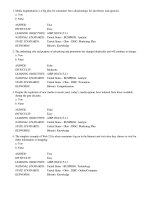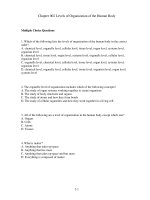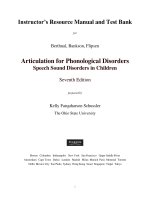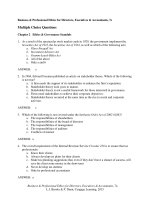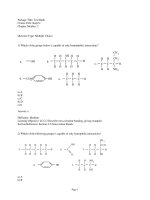Foundations and adult health nursing 7th edition cooper test bank
Bạn đang xem bản rút gọn của tài liệu. Xem và tải ngay bản đầy đủ của tài liệu tại đây (156.32 KB, 10 trang )
Chapter 2: Legal and Ethical Aspects of Nursing
Cooper and Gosnell: Foundations and Adult Health Nursing, 7th Edition
MULTIPLE CHOICE
1. When a nurse becomes involved in a legal action, the first step to occur is that a document is
filed in an appropriate court. What is this document called?
a. Deposition
b. Appeal
c. Complaint
d. Summons
ANS: C
A document called a complaint is filed in an appropriate court as the first step in litigation. A
deposition is when witnesses are required to undergo questioning by the attorneys. An appeal
is a request for a review of a decision by a higher court. A summons is a court order that
notifies the defendant of the legal action.
PTS: 1
DIF: Cognitive Level: Knowledge
REF: Page 23
OBJ: 1
TOP: Legal
KEY: Nursing Process Step: N/A
MSC: NCLEX: N/A
2. The nurse caring for a patient in the acute care setting assumes responsibility for a patient’s
care. What is this legally binding situation?
a. Nurse-patient relationship
b. Accountability
c. Advocacy
d. Standard of care
ANS: A
When the nurse assumes responsibility for a patient’s care, the nurse-patient relationship is
formed. This is a legally binding “contract” for which the nurse must take responsibility.
Accountability is being responsible for one’s own actions. An advocate is one who defends or
pleads a cause or issue on behalf of another. Standards of care define acts whose performance
is required, permitted, or prohibited.
PTS: 1
DIF: Cognitive Level: Comprehension
REF: Page 24
OBJ: 3
TOP: Legal
KEY: Nursing Process Step: N/A
MSC: NCLEX: N/A
3. What are the universal guidelines that define appropriate measures for all nursing
interventions?
a. Scope of practice
b. Advocacy
c. Standard of care
d. Prudent practice
ANS: C
Standards of care define actions that are permitted or prohibited in most nursing interventions.
These standards are accepted as legal guidelines for appropriateness of performance. The laws
that formally define and limit the scope of nursing practice are called nurse practice acts. An
advocate is one who defends or pleads a cause or issue on behalf of another. Prudent is a term
that refers to careful and/or wise practice.
PTS: 1
DIF: Cognitive Level: Knowledge
REF: Page 25
OBJ: 4
TOP: Legal
KEY: Nursing Process Step: N/A
MSC: NCLEX: N/A
4. An LPN/LVN is asked by the RN to administer an IV chemotherapeutic agent to a patient in
the acute care setting. What law should this nurse refer to before initiating this intervention?
a. Standards of care
b. Regulation of practice
c. American Nurses’ Association Code
d. Nurse practice act
ANS: D
It is the nurse’s responsibility to know the nurse practice act in his or her state. Standards of
care, regulation of practice, and the American Nurses’ code are not laws that the nurse should
refer to before initiating this treatment.
PTS: 1
DIF: Cognitive Level: Application
REF: Page 25
OBJ: 5
TOP: Legal
KEY: Nursing Process Step: N/A
MSC: NCLEX: N/A
5. A nurse fails to irrigate a feeding tube as ordered, resulting in harm to the patient. This nurse
could be found guilty of:
a. malpractice.
b. harm to the patient.
c. negligence.
d. failure to follow the nurse practice act.
ANS: A
The nurse can be held liable for malpractice for acts of omission. Failure to meet a legal duty,
thus causing harm to another, is malpractice. The nurse practice act has general guidelines that
can support the charge of malpractice.
PTS: 1
DIF: Cognitive Level: Application
REF: Pages 22-23
OBJ: 2
TOP: Legal
KEY: Nursing Process Step: N/A
MSC: NCLEX: N/A
6. Patients have expectations regarding the health care services they receive. To protect these
expectations, which of the following has become law?
a. American Hospital Association’s Patient’s Bill of Rights
b. Self-determination act
c. American Hospital Association’s Standards of Care
d. The Joint Commission’s rights and responsibilities of patients
ANS: A
Patients have expectations regarding the health care services they receive. In 1972, the
American Hospital Association (AHA) developed the Patient’s Bill of Rights. The
Self-determination act, American Hospital Association’s Standards of Care, and The Joint
Commission’s rights and responsibilities do not address patients’ expectations regarding
health care.
PTS: 1
DIF: Cognitive Level: Comprehension
REF: Page 26
OBJ: 3 | 4
TOP: Legal
KEY: Nursing Process Step: N/A
MSC: NCLEX: N/A
7. The nurse is preparing the patient for a thoracentesis. What must be completed before the
procedure may be performed?
a. Physical assessment
b. Interview
c. Informed consent
d. Surgical checklist
ANS: C
The doctrine of informed consent refers to full disclosure of the facts the patient needs to
make an intelligent (informed) decision before any invasive treatment or procedure is
performed. A physical assessment, interview, and surgical checklist are not required before
this procedure.
PTS: 1
DIF: Cognitive Level: Application
REF: Pages 26-27
OBJ: 8
TOP: Legal
KEY: Nursing Process Step: N/A
MSC: NCLEX: N/A
8. When a nurse protects the information in a patient’s record what ethical responsibility is the
nurse fulfilling?
a. Privacy
b. Disclosure
c. Confidentiality
d. Absolute secrecy
ANS: C
The nurse has an ethical and legal duty to protect information about a patient and preserve
confidentiality. Some disclosures are legal and anticipated, and may not be subject to the rules
of confidentiality. None of the information in a chart is considered secret.
PTS: 1
DIF: Cognitive Level: Comprehension
OBJ: 9
TOP: Confidentiality
MSC: NCLEX: N/A
REF: Page 28
KEY: Nursing Process Step: N/A
9. An older adult is admitted to the hospital with numerous bodily bruises, and the nurse
suspects elder abuse. What is the best nursing action?
a. Cover the bruises with bandages.
b. Take photographs of the bruises.
c. Ask the patient if anyone has hit her.
d. Report the bruises to the charge nurse.
ANS: D
The law stipulates that the health care professional is required to report certain information to
the appropriate authorities. The report should be given to a supervisor or directly to the police,
according to agency policy. When acting in good faith to report mandated information (e.g.,
certain communicable diseases or gunshot wounds), the health care professional is protected
from liability.
PTS: 1
DIF: Cognitive Level: Application
REF: Page 29
OBJ: 9
TOP: Elder abuse KEY: Nursing Process Step: N/A
MSC: NCLEX: N/A
10. What is the best way for a nurse to avoid a lawsuit?
a. Carry malpractice insurance
b. Spend time with the patient
c. Provide compassionate, competent care
d. Answer all call lights quickly
ANS: C
The best defense against a lawsuit is to provide compassionate and competent nursing care.
Carrying malpractice insurance is prudent, but it will not avoid a lawsuit. Spending time with
patients and answering call lights quickly will not necessarily help avoid a lawsuit.
PTS: 1
DIF: Cognitive Level: Comprehension
OBJ: 8
TOP: Avoiding a lawsuit
MSC: NCLEX: N/A
REF: Pages 29-30
KEY: Nursing Process Step: N/A
11. The nurse is caring for a patient with a do-not-resuscitate (DNR) order. Although the nurse
may disagree with this order, what is his or her legal obligation?
a. To question the doctor
b. To seek advice from the family
c. To discuss it with the patient
d. To follow the order
ANS: D
When a DNR order is written in the chart, the nurse has a duty to follow the order.
Questioning the doctor, seeking advice from the family, and discussing it with the patient are
not legal obligations of the nurse.
PTS: 1
DIF: Cognitive Level: Application
REF: Page 35
OBJ: 10 | 14
TOP: Legal
KEY: Nursing Process Step: N/A
MSC: NCLEX: N/A
12. The nurse has strong moral convictions that abortions are wrong. When assigned to assist with
an abortion, what is the most appropriate action for the nurse to take?
a. Ask for another assignment
b. Leave work
c. Transfer to another floor
d. Protest to the supervisor
ANS: A
The nurse should not abandon the patient, but ask for another assignment.
PTS: 1
DIF: Cognitive Level: Application
REF: Page 35
OBJ: 9 | 16
TOP: Ethics
MSC: NCLEX: N/A
KEY: Nursing Process Step: N/A
13. The new LPN/LVN is concerned regarding what should or should not be done for patients.
What resource will best provide this information?
a. Nurse practice act
b. Standards of care
c. Scope of nursing practice
d. Professional organizations
ANS: B
Standards of care define what should or should not be done for patients. The nurse practice
act, scope of nursing practice, and professional organizations do not provide the best
information as to what should or should not be done for patients.
PTS: 1
DIF: Cognitive Level: Comprehension
OBJ: 5
TOP: Standards of care
MSC: NCLEX: N/A
REF: Page 25
KEY: Nursing Process Step: N/A
14. What role is the nurse who diligently works for the protection of patients’ interests playing?
a. Caregiver
b. Health care administrator
c. Advocate
d. Health care evaluator
ANS: C
A nurse accepts the role of advocate when, in addition to general care, the nurse protects the
patient’s interests. Caregiver, health care administrator, and health care evaluator are not
terms for the nurse who diligently works for the protection of patients.
PTS: 1
DIF: Cognitive Level: Comprehension
REF: Page 24
OBJ: 9 | 12
TOP: Advocate
KEY: Nursing Process Step: N/A
MSC: NCLEX: N/A
15. When asked to perform a procedure that the nurse has never done before, what should the
nurse do to legally protect himself or herself?
a. Go ahead and do it
b. Refuse to perform it, citing lack of knowledge
c. Discuss it with the charge nurse, asking for direction
d. Ask another nurse who has performed the procedure
ANS: C
The nurse cannot use ignorance as an excuse for nonperformance. The nurse should ask for
direction from the charge nurse, explaining she has never performed the procedure
independently.
PTS: 1
DIF: Cognitive Level: Application
REF: Page 25
OBJ: 8
TOP: Legal
KEY: Nursing Process Step: N/A
MSC: NCLEX: N/A
16. The nurse is assisting a patient to clarify values by encouraging the expression of feelings and
thoughts related to the situation. What is the most appropriate action for the nurse?
a.
b.
c.
d.
Compare values with those of the patient
Make a judgment
Withhold an opinion
Give advice
ANS: C
The nurse can assist the patient in values clarification without giving an opinion.
PTS: 1
DIF: Cognitive Level: Application
OBJ: 3 | 8
TOP: Values clarification
MSC: NCLEX: N/A
REF: Pages 33-34
KEY: Nursing Process Step: N/A
17. What fundamental principle must the nurse first observe when confronted with an ethical
decision?
a. Autonomy
b. Beneficence
c. Respect for people
d. Nonmaleficence
ANS: C
The first fundamental principle is respect for people. Autonomy, beneficence, and
nonmaleficence are not the first fundamental principles to observe when confronted with an
ethical decision.
PTS: 1
DIF: Cognitive Level: Comprehension
REF: Page 34
OBJ: 13 | 15
TOP: Ethics
KEY: Nursing Process Step: N/A
MSC: NCLEX: N/A
18. A nurse working on an acute care medical surgical unit is aware that his or her first duty is to
the patient’s health, safety, and well-being. Given this knowledge, which of the following is
most necessary for the nurse to report?
a. Unethical behavior of other staff members
b. A worker who arrives late
c. Favoritism shown by nursing administration
d. Arguments among the staff
ANS: A
A member of the nursing profession must report behavior that does not meet established
standards. Unethical behavior involves failing to perform the duties of a competent caring
nurse.
PTS: 1
DIF: Cognitive Level: Application
OBJ: 13
TOP: Unethical behavior
MSC: NCLEX: N/A
REF: Page 35
KEY: Nursing Process Step: N/A
19. A nurse is considering purchasing malpractice insurance. What should the nurse be aware of
regarding malpractice insurance provided by the hospital?
a. Only offers protection while on duty
b. Is limited in the amount of coverage
c. Is difficult to renew
d. Can be terminated at any time
ANS: A
Most institutional insurance only provides liability coverage if the nurse is on duty at that
facility.
PTS: 1
DIF: Cognitive Level: Comprehension
OBJ: 2
TOP: Malpractice insurance KEY:
MSC: NCLEX: N/A
REF: Page 30
Nursing Process Step: N/A
20. Which is a nursing care error that violates the Health Insurance Portability and Accountability
Act (HIPAA)?
a. Administering a stronger dose of drug than was ordered
b. Refusing to give a patient’s daughter information over the phone
c. Informing the patient’s medical power of attorney of a medication change
d. Leaving a copy of the patient’s history and physical in the photocopier
ANS: D
Leaving the document in the photocopier could expose it to the public. Inappropriate drug
administration is possible malpractice. Sharing information with the power of attorney is
legal. Refusing to give a patient’s daughter information over the phone is appropriate practice.
PTS: 1
DIF: Cognitive Level: Comprehension
REF: Pages 26, 28
OBJ: 7
TOP: Health Insurance Portability and Accountability Act (HIPAA)
KEY: Nursing Process Step: N/A
MSC: NCLEX: N/A
21. Which of the following could cause a nurse to be cited for malpractice?
a. Refusing to give 60 mg of morphine as ordered
b. Giving prochlorperazine (Compazine) to a patient allergic to phenothiazines
c. Dragging an injured motorist off the highway and causing further injury
d. Informing a visitor about a patient’s condition
ANS: B
Standards of care dictate that a nurse must be aware of all the properties of drugs
administered. Prochlorperazine (Compazine) is a phenothiazine. Providing confidential
information or refusing to give an excessively large narcotic dose is not considered
malpractice. Good Samaritan laws generally protect a person giving aid to an injured motorist.
PTS: 1
DIF: Cognitive Level: Application
REF: Pages 22-23
OBJ: 2
TOP: Malpractice KEY: Nursing Process Step: N/A
MSC: NCLEX: N/A
22. A lumbar puncture was performed on a patient without a signed informed consent form. This
patient might sue for:
a. punitive damages.
b. civil battery.
c. assault.
d. nothing; no violation has occurred.
ANS: B
Civil battery charges can be brought against someone performing an invasive procedure
without the patient’s informed consent legally documented. This patient could not sue for
punitive damages or an assault.
PTS: 1
DIF: Cognitive Level: Comprehension
OBJ: 6 | 8
TOP: Informed consent
MSC: NCLEX: N/A
REF: Page 28
KEY: Nursing Process Step: N/A
23. A physician instructs the nurse to bladder train a patient. The nurse clamps the patient’s
indwelling urinary catheter but forgets to unclamp it. The patient develops a urinary tract
infection. What do the nurse’s actions exemplify?
a. Malpractice
b. Battery
c. Assault
d. Neglect of duty
ANS: A
A nurse is liable for acts of commission (doing an act) and omission (not doing an act)
performed in the course of their professional duty. A charge of malpractice is likely when a
duty exists, there is a breach of that duty, and harm has occurred to the patient.
PTS: 1
DIF: Cognitive Level: Application
REF: Pages 22-23
OBJ: 2
TOP: Malpractice KEY: Nursing Process Step: N/A
MSC: NCLEX: N/A
24. What is true about nurse practice acts?
a. They informally define the scope of nursing practice.
b. They provide for unlimited scope of nursing practice.
c. Only some states have adopted a nurse practice act.
d. The nurse must know the nurse practice act within his or her state.
ANS: D
The laws formally defining and limiting the scope of nursing practice are called nurse practice
acts. All state, provincial, and territorial legislatures in the United States and Canada have
adopted nurse practice acts, although the specifics they contain often vary. It is the nurse’s
responsibility to know the nurse practice act that is in effect for her geographic region.
PTS: 1
DIF: Cognitive Level: Comprehension
OBJ: 1
TOP: Nurse practice acts
MSC: NCLEX: N/A
REF: Page 25
KEY: Nursing Process Step: N/A
MULTIPLE RESPONSE
25. How can the medical record be used in litigation? (Select all that apply.)
a. Public record
b. Proof of adherence to standards
c. Evidence of omission of care
d. Documentation of time lapses
e. Evidence by only the plaintiff
ANS: A, B, C, D
The information when used in court becomes a public record. The information can be used as
proof of adherence to standards, omission of care, and documentation of time lapses. Both
plaintiff and defendant can use the document.
PTS: 1
DIF: Cognitive Level: Comprehension
OBJ: 4
TOP: Legal properties of medical record
MSC: NCLEX: N/A
REF: Page 28
KEY: Nursing Process Step: N/A
26. During a lunch break, an emergency department (ED) nurse truthfully tells another nurse
about the condition of a patient who came to the ED last night. What is the ED nurse guilty
of? (Select all that apply.)
a. HIPAA violation
b. Slander
c. Libel
d. Invasion of privacy
e. Defamation
ANS: A, D
The disclosure is an invasion of privacy and a violation of HIPAA. Because the information is
true and verbal, it cannot be considered slander or libel.
PTS: 1
DIF: Cognitive Level: Application
OBJ: 7
TOP: Disclosure of information
MSC: NCLEX: N/A
REF: Pages 26, 28
KEY: Nursing Process Step: N/A
27. A nurse failed to monitor a patient’s respiratory status after medicating the patient with a
narcotic analgesic. The patient’s respiratory status worsened, requiring intubation. The
patient’s family claimed the nurse committed malpractice. What must be present for the nurse
to be held liable? (Select all that apply.)
a. A nurse-patient relationship exists.
b. The nurse failed to perform in a reasonable manner.
c. There was harm to the patient.
d. The nurse was prudent in her performance.
e. The nurse did not cause the patient harm.
f. Duty does not exist.
ANS: A, B, C
For the court to uphold the charge of malpractice, and to find the nurse liable, the following
elements must be present: duty exists, there is a breach of duty, and harm must have occurred.
PTS: 1
DIF: Cognitive Level: Application
REF: Page 24
OBJ: 2
TOP: Malpractice KEY: Nursing Process Step: N/A
MSC: NCLEX: N/A
COMPLETION
28. Personal beliefs about the worth of an object, idea, custom, or attitude that influence a
person’s behavior in a given situation are referred to as ___________.
ANS:
values
Values are personal beliefs about the worth of an object, an idea, a custom, or an attitude.
Values vary among people and cultures; they develop over time and undergo change in
response to changing circumstances and necessity. Each of us adopts a value system that will
govern what we feel is right or wrong (or good and bad) and will influence our behavior in a
given situation.
PTS: 1
DIF: Cognitive Level: Knowledge
REF: Page 33
OBJ: 11 | 12
TOP: Values
KEY: Nursing Process Step: N/A
MSC: NCLEX: N/A
29. Acts whose performance is required, permitted, or prohibited are defined by ___________ of
______________.
ANS:
standards, care
Standards of care define acts whose performance is required, permitted, or prohibited.
PTS: 1
DIF: Cognitive Level: Knowledge
OBJ: 4
TOP: Standards of care
MSC: NCLEX: N/A
REF: Page 25
KEY: Nursing Process Step: N/A
